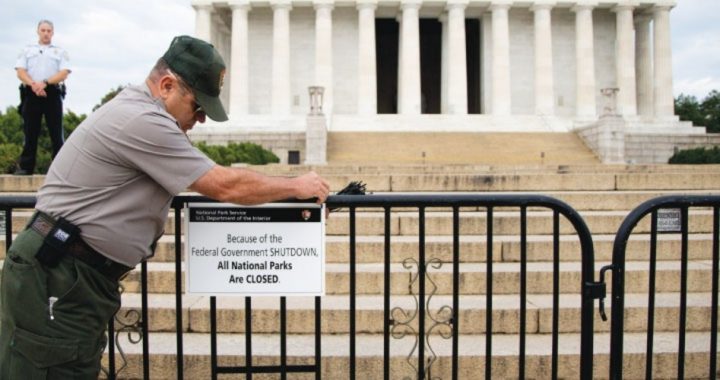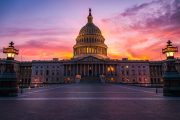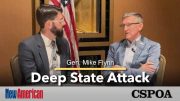
With the recent partial government shutdown now behind us, the jubilant mainstream media and triumphalist Democrats are declaring total victory for the Obama administration, the new regime of quasi-socialized medicine known as ObamaCare, and the cause of Big Government generally. Indeed, as they always have in the past, the Republican leadership — at least, those who currently enjoy the perks of seniority in the House and Senate — caved ignominiously and unconditionally to their Democratic adversaries, in this case Barack Obama and his Senate attack dog, Harry Reid.
Post-shutdown Republican establishment rhetoric positively reeks of embarrassment at the cadre of Young Turks who, for a few glorious days at least, appeared to have wrested the reins of leadership from a GOP establishment that never met a Big Government initiative or a debt limit increase that they could not find a way to accommodate. But in the end, the establishment got its way, and Washington is already joyously adding hundreds of billions of dollars to the national debt, even as ObamaCare sets about destroying America’s once-free healthcare system.
Still, those who — such as Senators Ted Cruz, Mike Lee, and Rand Paul — opposed ObamaCare in principle and refused to authorize another debt-ceiling hike can take some comfort that standing for principle even in the face of steep odds has proven instructive, and may yield a harvest in lower spending and limited government somewhere down the road. The lessons learned and re-learned during episodes such as the latest shutdown may someday prompt more than a small minority of patriots to embrace anew the program of our Founders, and allow for a return to constitutional government.
Lesson Number One
The first and most glaring lesson is that Washington insiders will stop at nothing to prevent government shrinkage. News coverage of the shutdown was quite possibly the most biased ever seen, with one post-shutdown study by Media Research Center of the reporting by CBS, ABC, and NBC showing not a single story singling out the Democrats for blame. Specifically, out of 124 total stories covering the event, 41 blamed Republicans or conservatives, 17 blamed both parties, and not a single one blamed Democrats or liberals. What the 20 million viewers of those three networks heard, concluded the MRC, “was a version of the shutdown story that could easily have emanated from Barack Obama’s own White House.”
In fact, what viewers of these and every other major news outlet — with the exception of Fox News — were subjected to was the real Washington laid bare, in all its raw cynicism, duplicity, and contempt for the concerns and well-being of Americans outside the Beltway. It was the parasitic establishment at its vindictive worst, heaping calumny and venom on a bold coalition that dared to threaten its latest, most brazen seizure yet of private assets and liberty, the comically misnamed Affordable Care Act. During the impasse, the rhetoric among Democrats and in the pro-Beltway mainstream media reached a fever pitch, with the leaders of the Republican opposition likened to jihadists and terrorists, and pilloried for their alleged callous and irresponsible behavior. Those of us who dared to dissent were treated to the sickening spectacle, day after day, of the likes of Rand Paul and Ted Cruz dragged before various inquisitorial media outlets to be hounded, hectored, and lectured in front of tens of millions by so-called journalists, such as CNN’s Candy Crowley and NBC’s Savannah Guthrie, who had abandoned any pretense of objectivity. And even with the resolution of the crisis — temporarily — the attacks continue at a withering pace, as the establishment continues to try to put upstart Tea Partiers in their place. “The president won this thing,” exulted CBS’ longtime establishment shill Bob Schieffer the day after the deal was cut. Lesson One: Washington insiders — politicians, lobbyists, bureaucrats, and journalists — care not a whit for anything but the power they have amassed, and will stop at nothing to defend it.
One of the least-remarked ironies of the shutdown was the notion that, as a Reuters story observed on October 1, the federal government had to divide its functions and employees between “essential” and “non-essential,” and had furloughed or idled the latter. Completely lost on the political establishment and on the kept media that serves as its mouthpiece was the hypocrisy of a government that claims to be running out of money and is tens of trillions of dollars in the hole already — yet was, by its own admission, spending billions of dollars on “non-essential” activities carried out by “non-essential” employees. In the private sector, successful firms do not waste time and money on non-essential activities and employees for very long; cronyism, quid pro quo, and bureaucratic creep are pitilessly penalized by the free market. But governments, it turns out, operate on incentives diametrically opposed to those that drive the free market. What economist Milton Friedman once characterized as a “reverse invisible hand” incentivizes government to reward the very things that free markets select against: profligacy instead of thrift, delay and red tape instead of efficiency, and indifference rather than a desire to serve the consumer. Government tends to perceive everything it does, and everyone in its employ, as indispensable, which is why, during the Great Recession, when the private sector was shedding tens of millions of jobs, shuttering factories, paying down debt, and ramping down production and spending, the federal government was spending and borrowing more than ever, creating vast new bureaucracies, and hiring thousands of new employees while making sure everyone already on the federal payroll stayed there. It’s also why, all the alarmist rhetoric notwithstanding, the recent shutdown was only a partial one, amounting to about 15 percent of government functions. In fact, the furlough of government employees during that period involved no layoffs at all, since they have all been awarded back pay for their time off.
Lesson Number Two
Lesson Two: The federal government believes that everything it does is essential, and is incapable of contemplating limits on its own power.
Forgotten or ignored in all the jockeying for political advantage during the shutdown was the fact that the Founders limited the federal government in the Constitution to those functions that they deemed “essential” — that is, those things that only a federal government (as opposed to state governments) could properly do, such as negotiate treaties with foreign powers, declare and conduct war, run a postal system, and deal with disputes between the states. And, lest there be any doubt among their posterity of the limits imposed on their federal creation, the Founders then clarified in the final amendment of the Bill of Rights — the 10th — that powers not expressly delegated by the Constitution to the federal government were understood to be reserved to the states or to the people. The federal government, in other words, was not to exercise any powers other than those enumerated in the Constitution.
Those enumerated powers were the “essential functions” of the federal government, though not necessarily of government in general. The Founders left open the possibility that state or local governments would choose to discharge functions above and beyond what the federal government was authorized to do. In the Founding Era and for generations thereafter, most government was, in fact, state or local. On the states, the Constitution only imposed the condition that they enjoy a republican form of government, but the latitude inherent in the federal system that it created ensured a wide diversity in the types of functions and services that state and local governments would have the power to perform.
During the 19th century, for instance, many states, following the example of Virginia, decided to create state universities that had as their core curricula the agricultural sciences. It was widely believed that encouragement of agriculture via teaching and research was enough of a public good to warrant funding at the state level. During that same period, local governments began setting up schools that were publically funded, and by the 1870s, all states had at least some publically funded elementary schools. Soon thereafter, states began passing laws making some level of education compulsory, reasoning that it would be in the public good. In other words, the providing of schools and universities came to be regarded as an “essential function” of government — but not of the federal government. In point of fact, America’s public and private education flourished until well into the 20th century — when the federal government became involved in education. Now, public schools are a disaster, and tuition at colleges and universities is far beyond what most people can afford. And this is because, at some juncture, Americans allowed themselves to be persuaded that federal government involvement in public (and private) education — dictating and standardizing curricula, subsidizing student loans, and subsidizing research, among many other things — is an “essential function” of the federal government.
The same could be said for much of what the federal government is now involved in. Nowhere does the Constitution authorize federal involvement in education, in healthcare, in food safety, in environmental regulations, in the stock markets, in the automobile industry, in the insurance sector, in the creation and maintenance of national parks, in the regulation of pharmaceuticals, in the legalization (or illegalization) of drugs, in the investigation or prosecution of crimes other than treason or piracy, in the regulation of firearms use and ownership, in the providing of retirement insurance (Social Security), in the stipulation of minimum wages, or in any of a host of other things now deemed “essential.”
The federal government, if reduced to its constitutionally mandated range of functions, would be only a tiny fraction of the sprawling, grasping monstrosity that now confronts us. Instead of presuming to run everything, the federal government would focus on doing those 20-odd things authorized by the Constitution. It would correspondingly cost a fraction of what it does now, and would begin, miraculously, to live within its means. The fact that none of this has happened or is even seriously discussed in Washington is a testimony to a general disregard for the Constitution inside the Beltway.
Lesson Number Three
Lesson Three: Few people in Washington have even a remote idea of what the Constitution stipulates, and most of those who do grasp its limits detest its limitations and routinely ignore and even ridicule it.
It may have come as a shock to some, especially to younger, more idealistic conservatives, Republicans, and patriots, but much of the strongest opposition to the efforts of Cruz, Paul, Lee, and company in the Senate and to the cadre of Tea Partiers in the House came from within the Republican Party. Old-guard GOP senators such as John McCain and Mitch McConnell made little effort to conceal their impatience with men they viewed as impudent upstarts and “wacko birds,” while Speaker of the House John Boehner tried his best to dissuade and divide those of his own party who had dug in their heels. But those of us who have been observing politics for a while have seen it all before: The GOP puts up token resistance, then caves. In this latest theater, the “compromise” spending bill not only gave the president and Democrats in Congress everything they demanded, it added billions in additional spending, some of which benefited Republicans such as McConnell.
Lesson Number Four
Lesson Four: Lean not on the broken reed of partisan politics, because there is not a dime’s worth of difference between Democrats and the GOP, at least at the level of power brokering.
The recent shutdown, involving as it did only the token and temporary elimination of a tiny part of constitutionally non-essential government, was nonetheless a welcome development. The very fact that Washington has been forced to admit that much of what it does is “non-essential” is an important wake-up call.
But the debate, even among leaders of the opposition such as Ted Cruz and Rand Paul, is still being framed mostly in terms of prudent public policy rather than constitutionality, which is why most extra-constitutional activities of the federal government are in no political jeopardy — yet. We may hope, however, that looming future shutdowns and policy debates — such as the sequester earlier this year — will lead to permanent reductions in the size and cost of the federal government, and to public awareness that, after all, those services were not needed, at least at the federal level. Over the longer haul, perhaps, government shutdowns and cutbacks could become a habit, leading, eventually, to a much smaller, constitutionally limited federal government that is more of a blessing for Americans than a burden.
— Photo: AP Images
This article is an example of the exclusive content that’s only available by subscribing to our print magazine. Twice a month get in-depth features covering the political gamut: education, candidate profiles, immigration, healthcare, foreign policy, guns, etc. Digital as well as print options are available!



